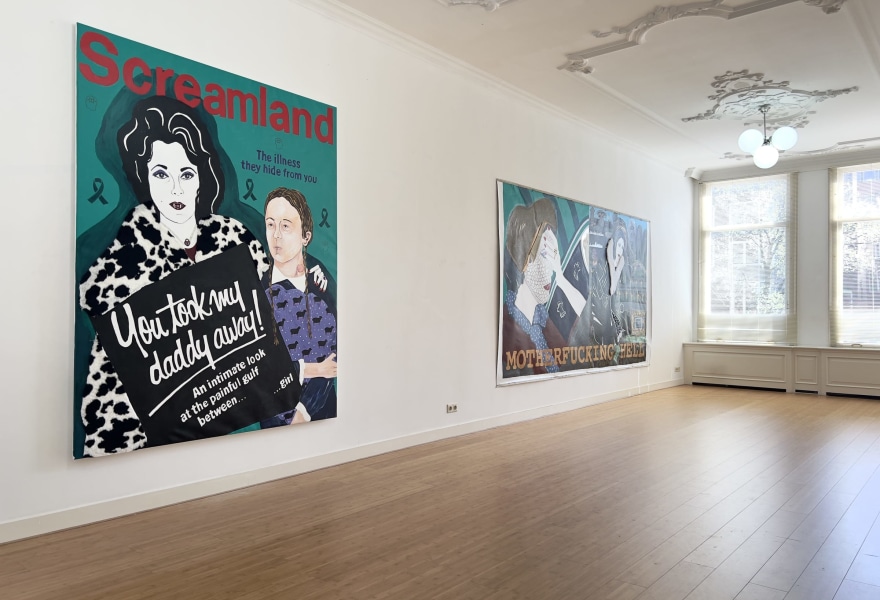24 april 2025, Flor Linckens
The gaze reflected: Kathe Burkhart at Ellen de Bruijne Projects
Until 10 May, Ellen de Bruijne Projects is presenting the exhibition 'Bloom & Doom', the first solo presentation of Kathe Burkhart at the gallery. Since the early 1980s, the American-Dutch artist has worked at the intersection of feminist visual culture, activism and autobiography. Her conceptual and interdisciplinary practice spans painting, video, collage, photography, performance and writing, and is defined by a distinct, uncompromising and outspoken visual language.
Burkhart engages with themes such as gender, power, representation, performativity, the body, exploitation, the tension between public and private, and the boundary between fiction and reality. Central to her work is the way in which female figures are constructed and represented in popular culture. She does not shy away from confrontation: her work is fierce, unmistakably personal and overtly political.
She often works in long-running series in which she brings together image and text through a bold, punk-related visual idiom marked by razor-sharp humour. Since 1982, Burkhart has been developing "The Liz Taylor Series", in which the American actress Elizabeth Taylor functions as an alter ego, archetype and performative mask. Taylor becomes a symbol and indirect self-portrait through which Burkhart raises more layered questions about femininity, identity, fame and power, and the patriarchal system in which these intersect. Her work also critically examines the gaze: the power dynamics between looking and being looked at. Her practice is grounded in both visual culture and academic discourse.
Burkhart draws from a personal archive of Elizabeth Taylor images, ranging from film stills and promotional portraits to paparazzi shots. Taylor’s life was relentlessly documented in the media, though she herself often appeared unfazed by it. Burkhart translates this imagery into large-scale paintings with explicit text, portraying Taylor as diva, victim, seductress or rebel. These vividly coloured works feature faux fur, fake tattoos, stickers and autobiographical objects. They oscillate between self-portrait and social critique, offering commentary on the roles that are still being imposed on women and gender-nonconforming people today. Burkhart, in many ways, reclaims authorship over that representation.
The exhibition includes several works from this series, including recent paintings in which English and Dutch slurs and slogans function as visual statements. Some resemble the front page of a tabloid.
Burkhart’s visual strategies are inseparably connected to language. She uses words as weapons, as tools for control and liberation. Together with the images, they generate a tension that compels the viewer to reflect, question or recoil. Her work confronts the viewer with women portrayed as loud, radical, dominant, abrasive, bitchy and nonconforming — words that clash with conventional expectations of what women are apparently supposed to be. Yet her use of such language is not merely provocative: it acts as a strategic intervention, disrupting the image, claiming space and challenging traditional depictions of femininity. In combining this with personal texts, feminist theory and autobiographical materials, Burkhart highlights the construction of identity in a media-saturated culture. Her works embody anger, pain and lived experience, while also opening up space for new ways of seeing.
In the gallery’s back space, Burkhart presents her new video work "Out of Time" (2025). Filmed in Times Square and the Keukenhof, both locations that are continuously documented and consumed — especially on social media — the piece combines these images with fragments from her journals and poetry, along with quotations from T.S. Eliot and Martin Heidegger. The film reflects on time, transience and the physical experience of space and liminality, forming a meditative counterpoint to the louder paintings shown at the front. The work explores a nonlinear experience of time, one that jumps forwards and backwards.
Kathe Burkhart was born in 1958 in Martinsburg, West Virginia, and studied at the California Institute of the Arts. She now divides her time between New York and Amsterdam. Her work has been exhibited at the Whitney Museum, MoMA PS1, the New Museum and the Brooklyn Museum, the Venice Biennale, the Art Institute of Chicago, the Stedelijk Museum and SMAK in Ghent. Her work is held in the collections of the Whitney Museum, the Art Institute of Chicago, Moderna Museet in Stockholm, SMAK in Ghent, the Stedelijk Museum and the Amsterdam Museum. Alongside her visual practice, Burkhart is also an author. She has published poetry, essays and four books of fiction, and contributed to various publications including Artforum, Hyperallergic, Cultural Politics, FlashArt and Women and Performance. In 2016, her archive was acquired by NYU, where she taught for many years. The following year she received a prestigious Guggenheim Fellowship.



